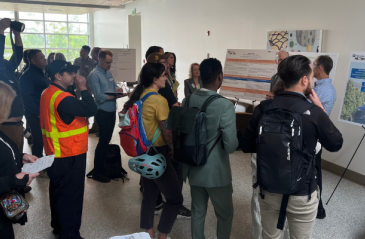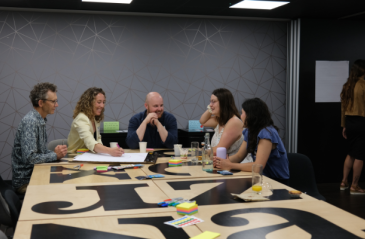
The information barriers holding back climate action and how to break them

Chile's new government lab is about a new way of doing, of thinking, of identifying solutions
Share articleIt aims to be a hub where people from the public, private and third sectors can come together
Share articleThe Lab is used to understand align reforms with what is available outside of government
Share articleWe put our vision for government into practice through learning partner projects that align with our values and help reimagine government so that it works for everyone.
Not many students take time out from their studies to go and work for their government, before returning to their books a couple of years later - but that's exactly what Nicolás Rebolledo did.
"I was doing a PhD at the Royal College of Art (RCA) in London," he recalls. "I'm looking at the expansion of the use of service design in different fields, particularly in the public sector. While researching this, and looking at things like the relationship of social and technological change in cities, I came across this announcement that the Chilean government wanted to create a new laboratory for public innovation. So I decided to get involved, and ended up being part of the team that designed the first phase of the government lab, turning this experience into the core of my PhD project."
It's quite a story, but one that Rebolledo is keen to downplay. For him, it was a natural extension of his role as a design strategist and practitioner, one who has already worked as an independent strategic design consultant for a range of startups, private companies, charities and public organisations. The hook this time was the opportunity to be involved in a new movement for change, one that could replicate in his native Chile the success of other government labs, such as Denmark's MindLab, the OPM Lab in the US, and the UK's Policy Lab.
Laboratorio de Gobierno, the first public service innovation lab inside the Chilean government, was set up for a range of reasons. The country has made much progress in recent years, including a new focus on government delivery, but there remained more to do. While the country's populace can now enjoy a far higher standard of living than previous generations, there is still much scope for further improvement - which is where the Lab came in.
"Its goal is to be an independent unit where people from the public, private and third sectors can come together to think of new ways of developing services for citizens," explains Rebolledo. "We wanted to improve the relationship between citizens and government through the deployment of user-centric public services." Its agenda reflected the challenges facing Chile's policymakers.
"Chile is now, some would say, facing a crisis similar to that of other middle-income countries," he continues. "The country is entering a new stage of its development, and the political agenda has shifted from poverty towards equality, from access to quality of public services, and from democratisation to participation and open government. This agenda is more similar to those facing governments in developed countries."
The country's president, Michelle Bachelet - who is both head of state and head of government - has introduced bold reforms in areas such as tax and the labour market, but Rebolledo says there is also a need to ensure the government itself can be fit for purpose and able to support the challenges of the new times. "I think there is an acknowledgement that to tackle the challenges of this new stage in the country's development, there is a need to invest in improving the machinery of government," he says.
“How to deliver services that can match the rising expectations of citizens? How to do it in a time of scarce resources? How to rebuild the trust between people and public institutions? How to manage the complexity of contemporary public problems?” These are all questions that conjure up a sort of perfect storm for the action of governments, adds Rebolledo. "In this context, it isn't just about modernisation, but innovation as well. Modernisation is about giving citizens access to government services, but innovation implies creating new ways of doing it. And this is what we need to do now."
Rebolledo is keen to stress that the Lab is about much more than just a new set of funds to deploy. Rather, it is about a new way of doing, of thinking, of identifying solutions. "It's about creating a space to work, cross-sector, towards creating new innovation processes," he explains. "It is based on experimentation and learning by doing, all in a controlled space where people can collaborate and test out new ideas and approaches. In other words, we wanted to think out of the box and be outside of the daily government processes."
He explains that the Lab's design is underpinned by a three-tier approach: firstly, understanding the complexity of the issues facing policymakers and society; secondly, mobilising civil servants; and thirdly, opening up government to other sectors in order to strengthen cross-sector collaboration.
"The bottom line was to use the Lab to really understand what is needed, and to align this need with what is available outside of government," he continues. "The first thing we needed to do was have a task force to understand the complexity of public services and the challenges they face. This was where we used Design to think about how to do things differently. The second element was about mobilising and capacity-building for civil servants. And the third was having enough money to pay for these innovation efforts - paying for the necessary transaction costs linked to these new innovative processes."
This approach was applied to issues ranging from healthcare to energy to transport. For each project, the team would research it and create new prototypes and concepts, collaborating with users and stakeholders to identify the best solutions. And at the same time, it would be creating new training and skills programmes to improve the capacities of civil servants.
“The possibility of tackling public challenges by creating this kind of institution was strengthened by the conviction of President Bachelet and her government and their support for the public innovation agenda,” says Rebolledo. “And its implementation and success is due to the strategic and hard work of a multidisciplinary team brilliantly led by Juan Felipe López, its executive director, who has been able to inspire and convene multiple stakeholders to collaborate in this effort.”
The next presidential election in Chile is fast approaching. And although Rebolledo is now back in London, he has long had the coming polling day in November as a key milestone. "The Lab has been operational for two years, and it has created strong social capital and enjoyed positive feedback from inside of government," he says. "But the biggest challenge now is to solidify the position of the Lab itself within the Chilean state so that it is secure, regardless of which political party is in power."
He is confident that its future is assured, but admits to some frustration that impact is often hard to quantify - particularly in the short term. "It is difficult to assess in the short term if an innovation has worked, because in the end it is about the value you are creating," he points out. "But if you view innovation in this context as about creating a movement of people around public problems, and you create social capital to deal with them, then I think this objective has absolutely been achieved."
Rebolledo is now working in London, where he is completing his PhD and leading the recently created Design for Policy platform within the Service Design programme at the RCA, where he teaches students about the role of design in public innovation. He is also working with government organisations in the UK and Latin America to show how design can support public sector innovation processes.
"What we do at the RCA in our Service Design programme is to work with a variety of organisations - both public and private sector - to create better services, systems and experiences for customers, and to help inform new strategies and policies for governments," he explains. "We work with them on a mix of projects - some short, some longer - about how we can use design for public and social innovation."
It's a busy portfolio, but one suspects that Rebolledo wouldn't have it any other way. And in any case, it seems that he will shortly have a whole new batch of colleagues to work alongside. "Interestingly, the students I teach are increasingly keen to get involved in creating solutions for public problems," he concludes. "More and more of them want to know how they can impact the environment, using design and other techniques to make a real difference. It's very encouraging - and exciting too."












